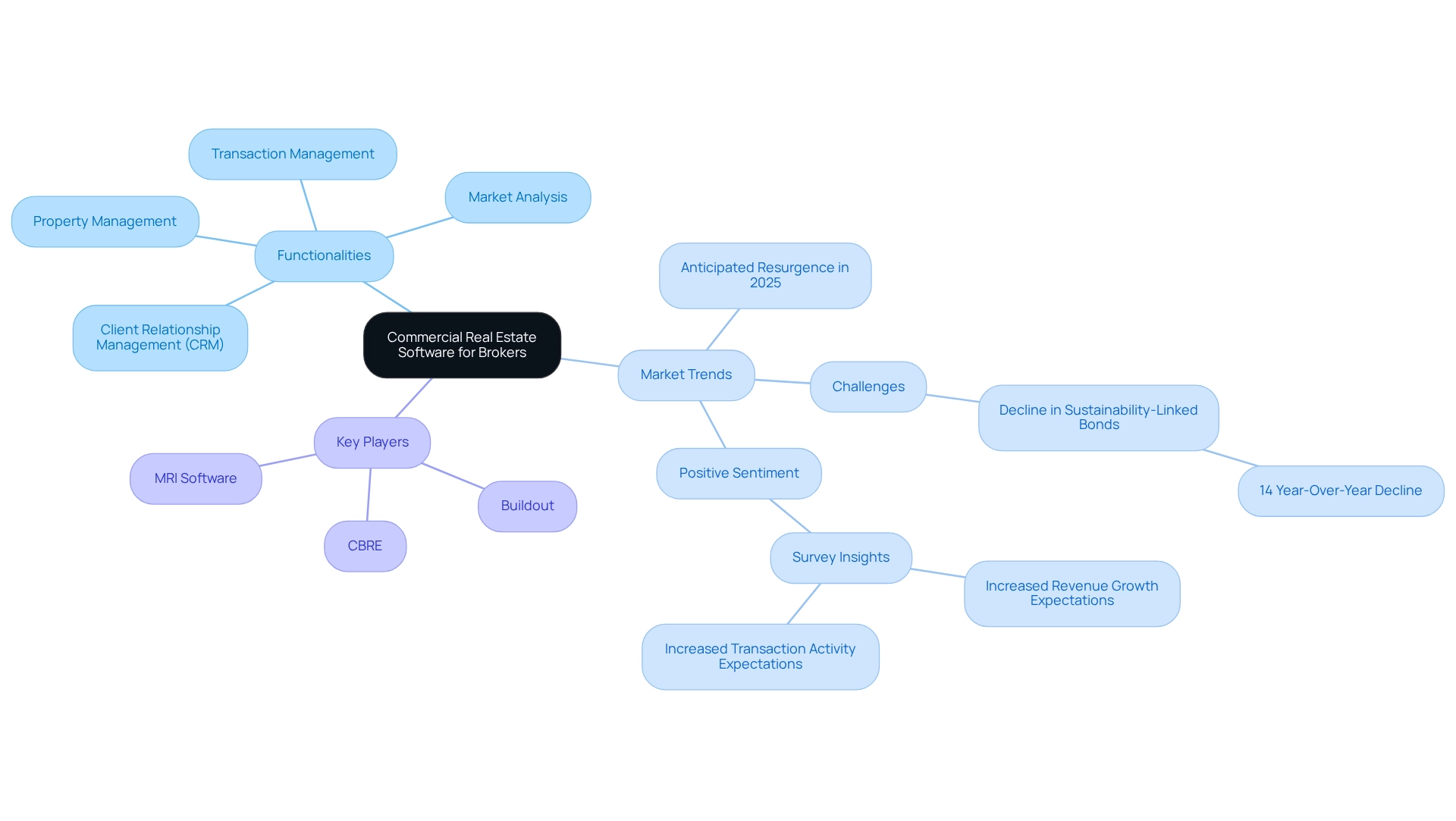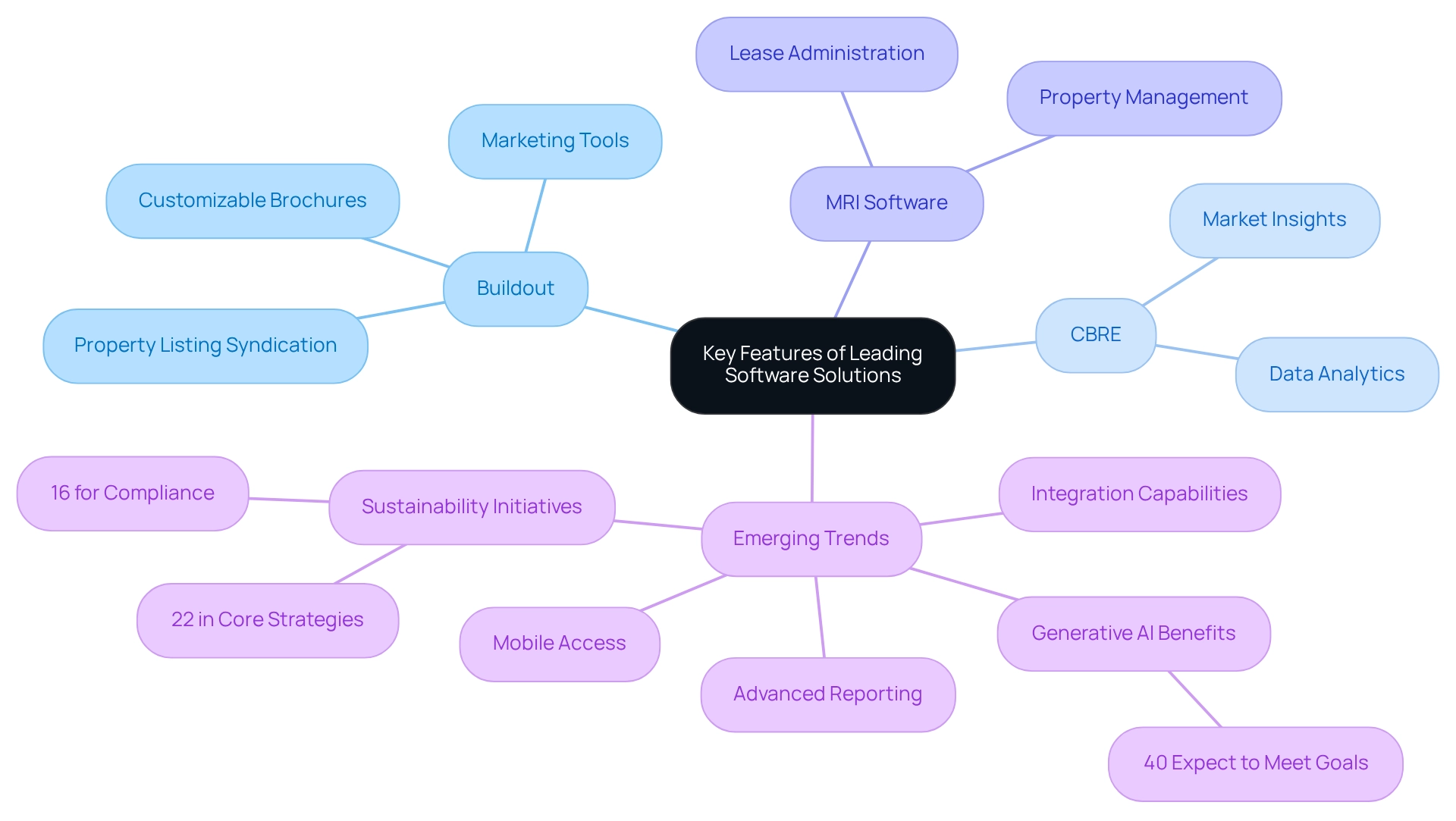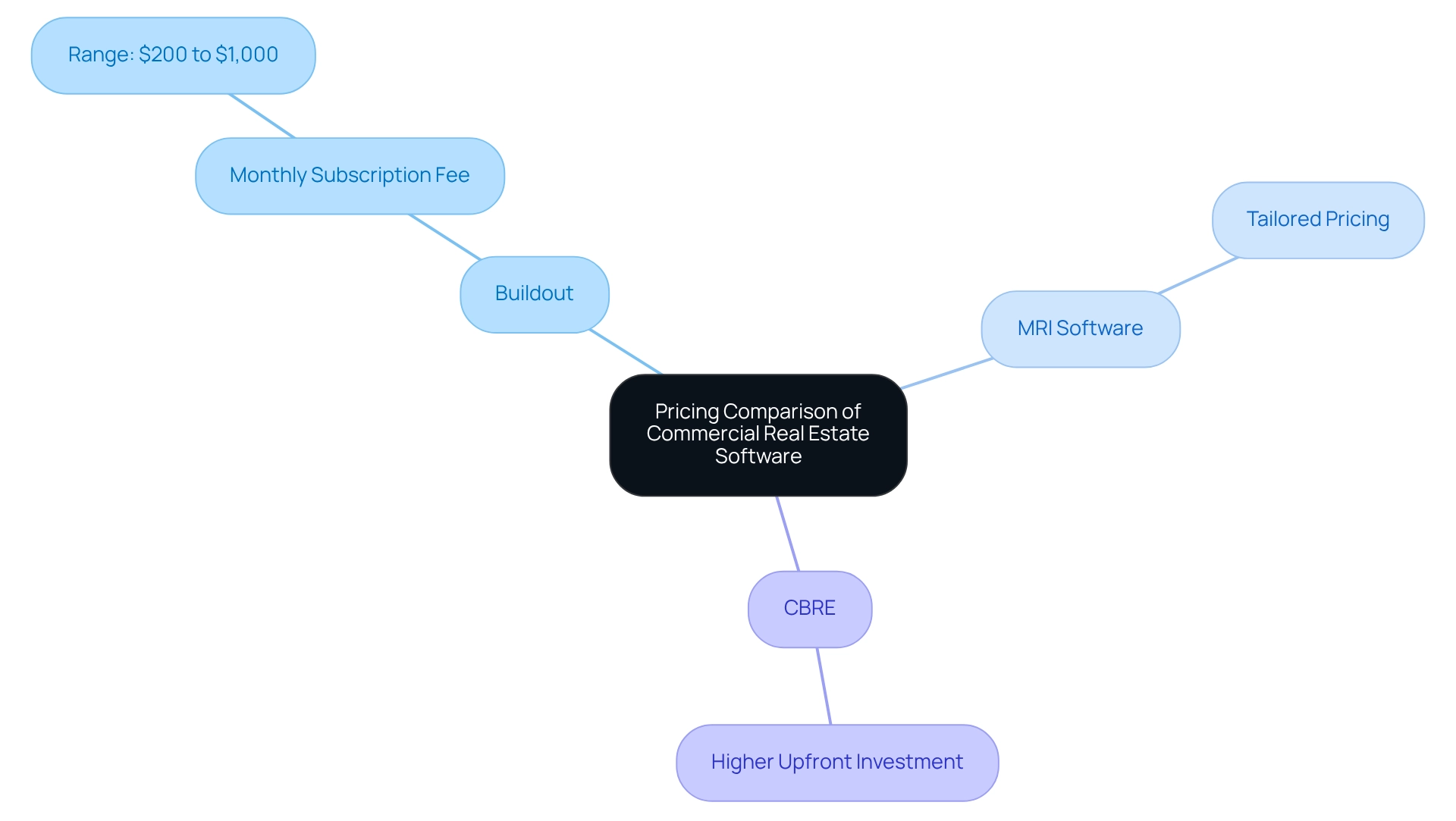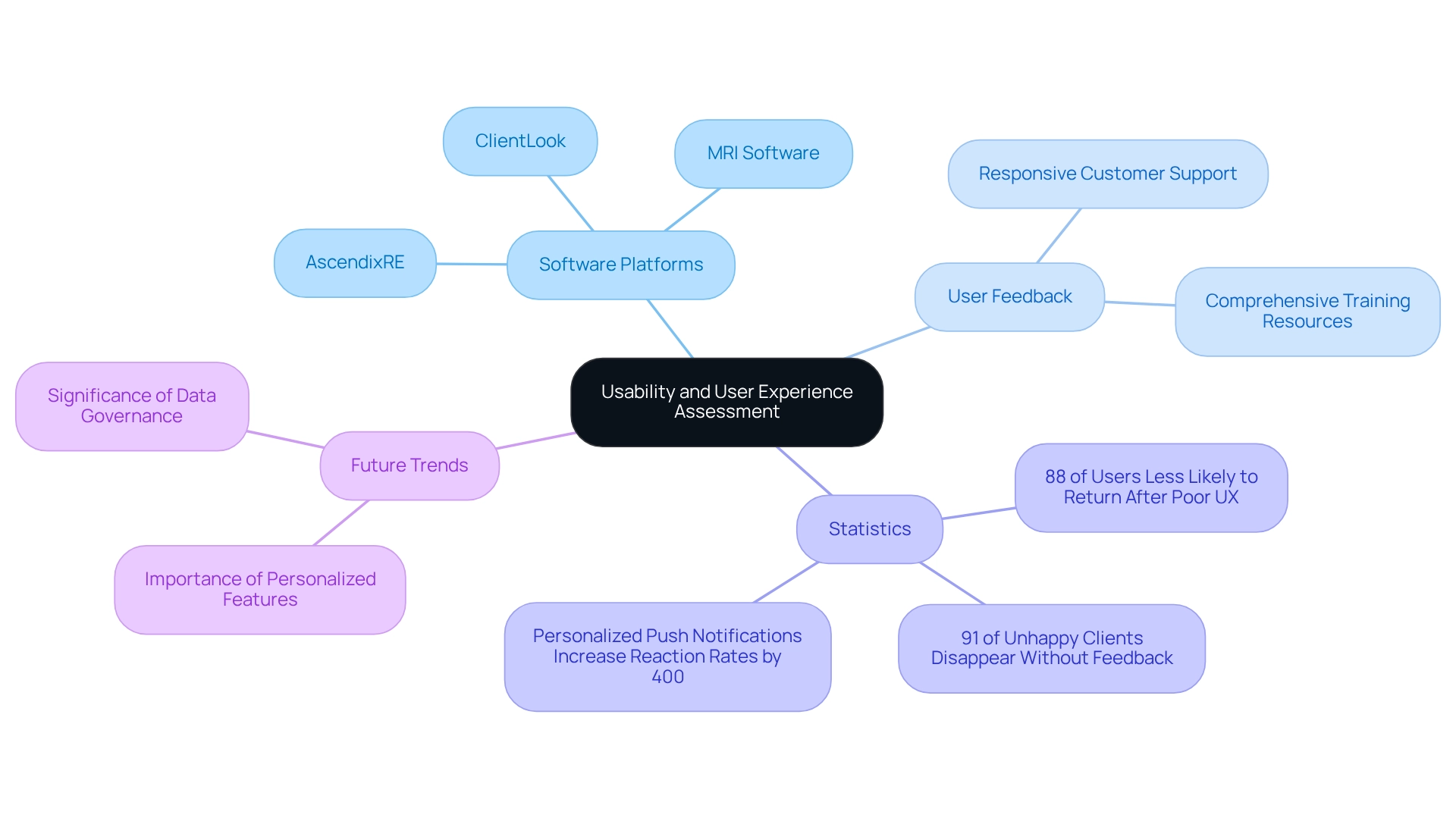Overview
This article presents a comparative analysis of commercial real estate software tailored for brokers, emphasizing its essential features, current market trends, and the critical role of usability in enhancing broker operations. It highlights that effective software solutions, including those offered by Buildout, CBRE, and MRI Software, not only streamline processes and improve client engagement but also adapt to the ever-evolving market dynamics. Such adaptability is vital for brokers striving to excel in a competitive landscape. By leveraging these insights, brokers can enhance their operational efficiency and client relationships, positioning themselves for success.
Introduction
In the dynamic realm of commercial real estate, technology is not merely an accessory; it is a fundamental component that shapes the industry's future. Brokers must navigate a landscape marked by evolving market conditions and shifting client expectations, making the integration of specialized software solutions essential. These tools streamline operations, enhance client interactions, and provide critical insights that drive strategic decisions.
As we look towards a promising revival in 2025, fueled by geopolitical stability and favorable interest rates, the significance of adopting advanced software cannot be overstated. This article explores the key features, pricing structures, and user experiences of leading commercial real estate software, illuminating how brokers can leverage these innovations to thrive in an increasingly competitive market.
Overview of Commercial Real Estate Software for Brokers
Commercial real estate software for brokers includes a diverse array of tools designed to streamline operations, enhance client engagement, and improve data management. These solutions typically include functionalities for:
- Property management
- Client relationship management (CRM)
- Market analysis
- Transaction management
As the commercial property landscape evolves, agents increasingly leverage technology to secure competitive advantages, manage extensive datasets, and deliver exceptional service to clients. Notably, the industry is on the brink of a revival in 2025, following years of subdued growth, driven by factors such as geopolitical stability and favorable interest rates. This anticipated resurgence is underscored by a recent survey indicating a positive shift in sentiment among property professionals, with expectations of increased revenue growth and transaction activity.
However, the financial landscape poses challenges, exemplified by the 14% year-over-year decline in the issuance of sustainability-linked bonds. This statistic underscores the complexities brokers must navigate in the current market environment. Key players in this sector, such as Buildout, CBRE, and MRI Software, provide commercial real estate software for brokers with tailored functionalities that cater to specific brokerage needs. The integration of commercial real estate software for brokers in commercial property brokerage is not merely a trend; it has become essential for operational efficiency.
As Deloitte observes, "Even though the business case for sustainability strategies is gaining ground, there remains a balancing act as firms try to evaluate short-term financial returns and long-term benefits." Statistics reveal that firms are increasingly investing in digital solutions to enhance their service offerings and streamline processes. Additionally, the case analysis titled 'Positive Sentiment in Property Recovery' illustrates the favorable shift in attitude regarding the property outlook, reinforcing the assertion of an expected resurgence in 2025. As the sector adapts to a digitally driven future, the incorporation of advanced technological solutions will be vital for agents aiming to thrive in a competitive marketplace.

Key Features of Leading Software Solutions
Leading commercial real estate software for brokers is meticulously tailored to meet the diverse needs of agents, offering a wide array of essential features. For instance, Buildout distinguishes itself with its comprehensive marketing tools, which encompass property listing syndication and customizable brochures that significantly enhance visibility and appeal. Conversely, CBRE's platform prioritizes data analytics and market insights, empowering agents to make informed investment decisions based on real-time information. MRI Software is recognized for its robust property management features, including sophisticated lease administration and financial reporting tools that streamline operations.
As the industry evolves, agents are increasingly pursuing mobile access for on-the-go management, allowing them to stay connected and responsive in a fast-paced environment. Integration capabilities with other applications have become essential, facilitating seamless workflows and data sharing. Furthermore, advanced reporting tools assist brokers in effectively tracking performance metrics, ensuring they can measure success and adapt strategies as necessary.
Notably, 40% of those realizing benefits from generative AI anticipate achieving their end goals within the next year, underscoring the growing reliance on technology within the brokerage sector. Additionally, the forthcoming generation of property talent is likely to possess tools that will transform traditional industry operations, highlighting the transformative potential of these technological solutions. A survey on high-growth property sectors has identified key asset classes presenting opportunities for property owners and investors. Digital economy properties, particularly data centers, remain a primary focus. This shift in investment priorities emphasizes the importance of technological solutions that align with emerging trends, including sustainability initiatives. Only 16% of respondents pursue these initiatives solely for compliance, while 22% integrate sustainability into their core business strategies. As the commercial property landscape continues to evolve, commercial real estate software for brokers is crucial in helping them navigate complexities and seize emerging opportunities.

Pricing Comparison of Commercial Real Estate Software
Costs associated with commercial real estate software for brokers vary significantly based on features, user quantity, and service tiers. For instance:
- Buildout typically imposes a monthly subscription fee ranging from $200 to $1,000, contingent upon the selected package.
- MRI Software's pricing is often tailored to meet the specific requirements of the brokerage.
- CBRE's platform may entail a higher upfront investment due to its comprehensive data analytics capabilities.
When evaluating application options, brokers must consider not only the initial costs but also potential long-term savings derived from improved efficiency and enhanced client service offered by commercial real estate software for brokers.

Usability and User Experience Assessment
Usability and user experience are pivotal factors in evaluating the effectiveness of commercial real estate software for brokers. Platforms like AscendixRE and ClientLook are often praised for their intuitive interfaces and straightforward navigation, enabling swift onboarding for new users. Conversely, more intricate systems such as MRI Software may require additional training to fully realize their capabilities.
User feedback highlights the importance of responsive customer support and comprehensive training resources, both of which can significantly enhance the overall user experience. Statistics indicate that 88% of users are less likely to return to a site after encountering poor user experience, underscoring the necessity for brokers to prioritize commercial real estate software for brokers that not only meets their functional needs but also guarantees a seamless and efficient user journey.
Moreover, 91% of dissatisfied clients who refrain from complaining simply vanish without providing feedback, emphasizing the critical repercussions of neglecting user experience. As the industry progresses into 2025, an unwavering focus on user experience will be vital for sustaining a competitive advantage, with personalized features and streamlined interfaces becoming increasingly essential.
For example, personalizing push notifications can elevate reaction rates by up to 400%, illustrating the significance of tailored user interactions. Case studies reveal that organizations adopting robust data governance practices have enhanced their data quality, resulting in more accurate analytics and insights, thereby further demonstrating the crucial connection between usability and effective decision-making when using commercial real estate software for brokers.
As Alicia Frazier, Senior Manager of Content & Communications, asserts, "Focusing on tenant experience is the top way to compete as the workplace continues to shift.

Conclusion
The commercial real estate industry stands poised for transformation, propelled by the integration of advanced software solutions that enhance operational efficiency and elevate client interactions. Brokers must adapt to a swiftly evolving landscape marked by changing market conditions and rising client expectations. Key features of leading software—such as robust property management tools, data analytics, and customizable marketing capabilities—empower brokers to make informed decisions and deliver exceptional service.
As we approach the anticipated revival in 2025, the importance of selecting the right software cannot be overstated. While pricing structures may vary, the long-term benefits of increased efficiency and strengthened client relationships often outweigh initial costs. Moreover, prioritizing usability and user experience is critical; brokers should focus on platforms that offer intuitive interfaces and responsive support, ensuring a seamless experience for both themselves and their clients.
In summary, the future of commercial real estate will be defined by those who embrace technology and leverage it to their advantage. By investing in the right software solutions, brokers can navigate the complexities of the market, capitalize on emerging opportunities, and ultimately thrive in an increasingly competitive environment. The integration of these innovations is not merely a trend but a necessity for success in the years to come.




